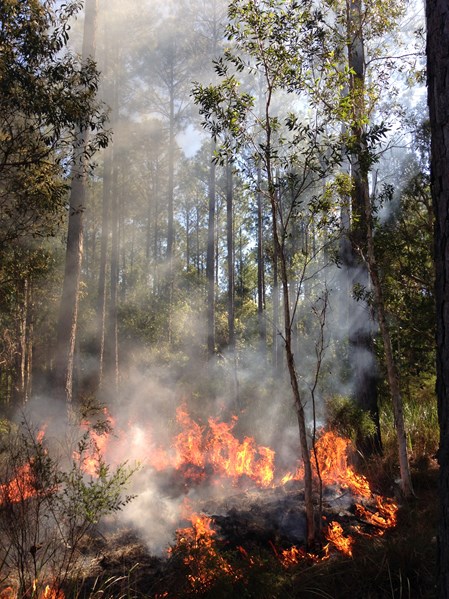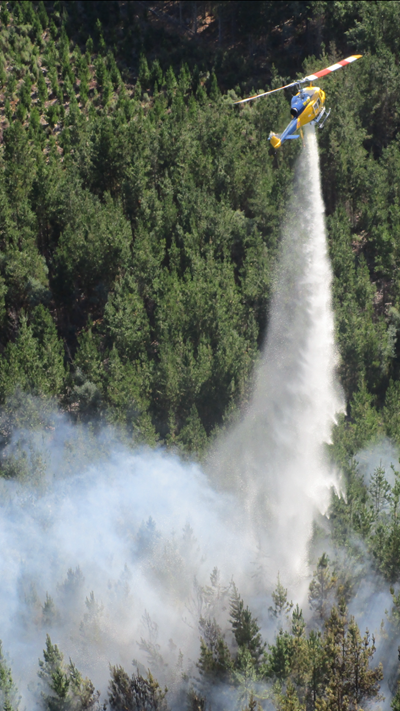We take a holistic approach to fire management
Prevention
Plantation forests have different fuel structures and more complex fire behaviour characteristics compared to other rural environments so prevention is important. Preventing fires in the first place is our best course of action. Our fire prevention strategies include:
- plantation design, fire line and fire break construction and maintenance
- prescribed burning in or adjacent to our plantations
- co-operative burns with neighbours
- slashing or chemical fuel reduction
- stock grazing
- education and awareness
- patrols in periods of high fire danger
- plantation closures in periods of very high fire danger.
Prescribed burning
Prescribed burning saves lives, property and wildlife.
Prescribed burns are low intensity fires that are performed under favourable conditions to minimise impacts on our estate and the communities that surround us. At the start of each burning season, and often in the days prior to a prescribed burn, we send a notification to those residents who may be affected.
We conduct an annual prescribed burn program in Southern Pine plantations and in native forest buffers adjacent to all plantation types during the cooler months as a component of our fuel management strategy. This decreases forest fuel loads from accumulated forest litter such as leaves, pine needles, grass and dead wood from the forest floor. It also improves the arrangement of fuels making the control of wildfires easier and safer. Fire danger usually increases in the spring and early summer months, when higher temperatures can combine with periods of lower rainfall and humidity.
See our interactive prescribed burning map and see where we are burning this week.
Fire preparedness
Our fire preparedness strategies include readiness before and during fire season.
HQPlantations is a Plantation Rural Fire Brigade registered with the Queensland Fire and Emergency Service (QFES) and training and accreditation is key to being ready.
We have over 250 trained fire fighters among our employees and contractors, almost 30 of these are accredited Incident Controllers. We also have over 40 logistics officers and a similar number of planning officers trained and ready to support them.
Weather forecasting and monitoring plays an important role in our readiness. We contract a professional weather service provider and operate 13 automatic weather stations across our plantation forests.
We also maintain thousands of kilometres of roads, tracks and fire breaks that provide access for fire management activities and firefighters.
Fire detection
Early detection is critical. We operate a network of fire towers, many of which are staffed in fire season, and 20 fire cameras that cover most of our estate, which are monitored from our regional offices all year round. All our fire cameras are linked to exci AI detection software which sends out automatic notifications of fires to our fire responders. This system can also detect and notify us of fires outside normal business hours.
During fire season, we conduct targeted vehicle patrols, occasional aerial surveillance and have recently introduced drone capability. Last but certainly not least, we also rely on reports from our neighbours, the public and Rural Fire Brigades.
Early detection and rapid response to bushfires gives crews a greater chance of extinguishing them while they are still relatively small.
Fire response
We have a lot of experience when it comes to responding to a wildfire. On average we respond to 130 wildfires each year.
We utilise the Australasian Inter-service Incident Management System - AIIMS system of fire incident management and operate a large fleet of more than 80 4WD fire fighting vehicles, including 12 tankers, from key locations across our estate. These are ready to be dispatched with crews to wherever they are needed.
In addition to our own firefighting fleet, we contract heavy machinery such as dozers, skidders and graders to establish or open up mineral earth fire lines for direct or indirect attack purposes.
In periods of very high fire danger, we also have fire attack helicopters on standby in strategic locations for rapid response. These are used conjunction with ground crews to suppress head fires and spot fires and to provide surveillance.


